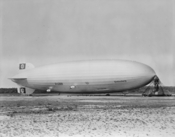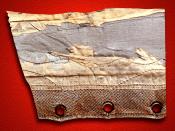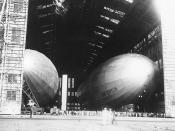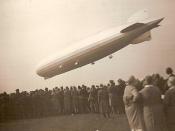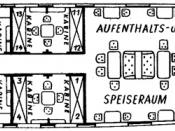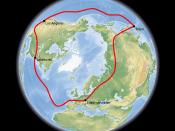Luftschiffbau Zeppelin was a German company owned by Ferdinand Graf von Zeppelin . This company was the world's most successful builder of rigid airships. Ferdinand Graf von Zeppelin flew the first airship in the world that was not tied down. This airship was called the LZ-1, and it was flown for the first time on July 2, 1900, near Lake Constance in Germany. This airship was carrying 5 passengers. The cloth-covered blimp, which was an example of many earlier models, had an aluminum frame, seventeen hydrogen cells, and two 15-horsepower Daimler internal combustion engines. It was about 420 feet long and 38 feet in diameter. When the airship was flown for the first time,it flew about 3.7 miles in 17 minutes and reached the height of 1,300 feet. The airship was very difficult to steer ,it needed more power and was experiencing many technical problems during its flight. These technical difficulties forced the giant airship to land in Lake Constance.
Zeppelin continued to improve his blimp and to build airships for the German government. In June 1910, the world's first commercial airship was called the Duestchland and another airship called the Sachsen followed in 1913. Between 1910 and the beginning of World War I in 1914, German zeppelins flew 107,208 miles and carried 34028 passengers and crew safely.
At the beginning of World War I, Germany had successfully developed 10 zeppelins. During the war Hugo Eckener ,a German engineer, helped the effort to win the war by training pilots and directing the construction of zeppelins for the Germany navy. By 1918, 67 zeppelins had been constructed, and only 16 of those zeppelins survived the war. During the war, the Germans used zeppelins to throw bombs. On May 31, 1915, the LZ-38 was the first zeppelin to bomb London. The airships could approach their opponents silently and fly at altitudes above all the British and French fighters.The zeppelins never really became effective assaulting weapons. A little while later new planes with more powerful engines that could go at higher altitudes were built, and the British and French planes also began to carry ammunition that contained phosphorus.Phosphorus is a solid non-metallic element that would set the zeppelins on fire, because they were filled with hydrogen. Very few zeppelins were also lost because of bad weather, and 17 were shot down because they could not fly as fast as the fighters.
At the end of the war, the German zeppelins that had not been captured were surrendered to the Allies because of the Treaty of Versailles.Eckener, who had assumed the company's presidency because of Count Zeppelin's death in 1917, suggested to the U.S. government that the company should build a giant zeppelin for the U.S. military to use. They suggested this because this would allow the company to stay in business. The United States agreed to this and on October 13, 1924, the U.S. Navy received the German ZR3 delivered personally by Eckener. The blimp, renamed the Los Angeles could carry 30 passengers and had sleeping areas similar to te ones on a Pullman railroad car. The Los Angeles made about 250 flights. When the restrictions imposed by the Treaty of Versailles on Germany were lifted, Germany was allowed to construct airships. Germany built three giant airships: the LZ-127 Graf Zeppelin, LZ-l29 Hindenburg, and LZ-l30 Graf Zeppelin II.
The Graf Zeppelin is considered the best airship ever built. It flew more miles than any airship had done to that time or would in the future. Its first flight was on September 18, 1928. In August 1929, it circled the globe. Its flight began with a trip from Friedrichshaften, Germany, to Lakehurst, New Jersey, allowing William Randolph Hearst, who had financed the trip in exchange for exclusive rights to the story, to claim that the voyage began from American soil. Piloted by Eckener, the craft stopped only at Tokyo, Japan, Los Angeles, California, and Lakehurst. The trip took 12 days-less time than the ocean trip from Tokyo to San Francisco.During the 10 years the Graf Zeppelin flew, it made 590 flights including 144 ocean crossings. It flew more than one million miles (1,609,344 kilometers), visited the United States, the Arctic, the Middle East, and South America, and carried 13,110 passengers.
When the Hindenburg was built in 1936, the Zeppelin company was at the ver successful.The Hindenburg was 804 feet long , had a maximum diameter of 135 feet , and contained seven million cubic feet of hydrogen in 16 cells. The airship could hold more than 70 passengers in luxurious comfort and had a dining room, library, lounge with a grand piano, and large windows. The Hindenburg's May 1936 launch started the first scheduled air service across the North Atlantic between Frankfurt , Main, Germany, and Lakehurst, New Jersey. Its first trip to the United States took 60 hours, and the return trip took only a quick 50. In 1936, it carried more than 1,300 passengers and several thousand pounds of mail and cargo on its flights. It had made 10 successful roundtrips between Germany and the United States. But that was soon forgotten. On May 6, 1937, as the Hindenburg was preparing to land at Lakehurst, New Jersey, its hydrogen ignited and the airship exploded and burned, killing 35 of the 97 people on board and one member of the ground crew. Its destruction, seen by horrified spectators in New Jersey, marked the end of the commercial use of airships.
Bibliographyhttp://en.wikipedia.org/wiki/Zeppelinhttp://www.answers.com/topic/zeppelinhttp://www.firstworldwar.com/bio/zeppelin.htmhttp://www.spartacus.schoolnet.co.uk/REVhistoryFWW3.htm
